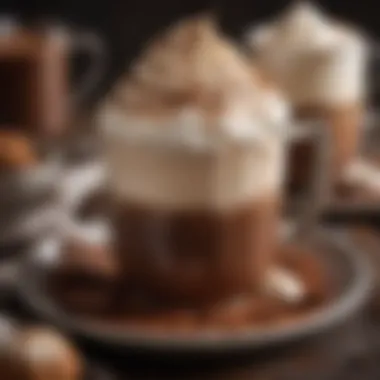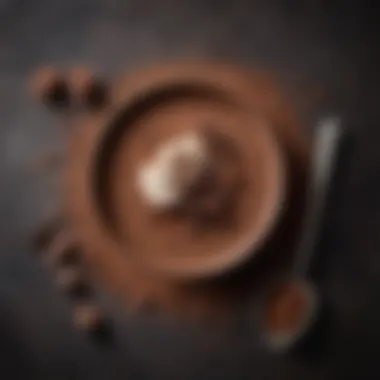Homemade Hot Chocolate: Mastering Cocoa Powder Delights


Intro
Hot chocolate, a beloved beverage for many, often evokes feelings of warmth and comfort. Mastering the art of crafting homemade hot chocolate using cocoa powder can enhance this experience significantly. If you're looking for a delightful treat that combines simplicity with rich flavors, this guide will serve you well. It addresses ingredient selection, preparation techniques, and variations to set apart your hot chocolate from the rest. This overview will not only inform both novice and experienced cooks but also invite busy individuals into an enjoyable cooking experience.
Recipe Highlight
Indulgent Cocoa Hot Chocolate
This recipe offers a rich and creamy indulgent cocoa hot chocolate. With a thoughtful balance of ingredients, it will satisfy anyone's cocoa cravings.
Essential Ingredients:
- 2 tablespoons of cocoa powder
- 2 tablespoons of sugar (adjust as desired)
- 1 cup of milk (any kind of milk can be used)
- 1/4 teaspoon of vanilla extract
- A pinch of salt
Preparation Time: Approximately 10 minutes.
Servings: This recipe yields one generous serving.
Step-by-Step Instructions
To make this indulgent cocoa hot chocolate, follow these steps:
- In a small saucepan, sift together the cocoa powder and sugar to eliminate lumps.
- Gradually whisk in the milk, mixing thoroughly until well combined.
- Place the saucepan over medium heat and continuously stir until the mixture is heated but not boiling.
- Once warm, remove from heat. Stir in the vanilla extract and a small pinch of salt to enhance the flavor.
- Optional: Bring back a small amount of milk to a froth in a separate pan and pour it over top for a velvety finish.
Helpful Cooking Techniques:
- Whisking continuously helps maintain a smooth texture.
- Consider using a frothing wand or an immersion blender for finer results.
Common Mistakes to Avoid:
- Don't let the milk reach boiling point as it can scorch.
- Ensure you taste the mix before serving; adjust sugar to your preference.
Variations and Substitutions
Adjusting your ingredients can elevate the cocoa hot chocolate. Here are some ideas:
- Milk Alternatives: Use almond, coconut, or oat milk.
- Sweeteners: Honey, maple syrup, or agave nectar can replace sugar. Adjust the amounts since these vary in sweetness.
- Flavor Enhancements: Stir in a teaspoon of cinnamon or chili powder for a spicy warmth.
- Add-Ins: Marshmallows, whipped cream, or chocolate shavings make great toppings.
Time-Saving Cooking Tips
Efficient preparation can save you time in the kitchen:
- Prep Ingredients in Advance: Measure cocoa, sugar, and milk beforehand for quicker assembly.
- Use Simple Tools: A microwave can quickly heat milk if you’re short on time.
- Batch Cooking: Prepare hot chocolate in larger quantities and store leftovers in the fridge. Reheat as needed.
Nutritional Information
One serving of this cocoa hot chocolate roughly contains:
- Calories: 250 kcal
Key nutrients include:
- Protein: 8g from milk
- Carbohydrates: 30g, depending on sugar content chosen
Diet Suitability:
The recipe can accommodate dietary needs with simple adjustments. Using plant-based milk and natural sweeteners can make it vegan or lower in calories.
Often loved enjoys hot chocolate, it becomes more than just a drink. It evolves into an experience that celebrates comforting flavors. Mastering this simple yet refined recipe can bring joy not just to yourself but also to those you may choose to share with.
Find more about cocoa on sources like Wikipedia and explore recipes or discussions on platforms like Reddit.
Foreword to Homemade Hot Chocolate


Creating homemade hot chocolate using cocoa powder offers a delightful journey into the kitchen. It provides an opportunity to explore flavor profiles and discover the balance between quality ingredients and quick preparation. Hot chocolate is not just a warm drink; it is a nostalgic experience for many, evoking lasting memories. Well-prepared hot chocholate brings comfort in colder months and serves as an uplifting treat any time of year.
While countless packaged options exist, making hot chocolate at home presents distinct benefits. It allows control over the sweetness, richness, and consistencies of beverage. Moreover, crafting this drink can be a simple way to impress guests or serve your family an indulgent dessert that suits anyone’s taste preferences. Home cooked hot chocolate thus represents an art evoking luxury from everyday ingredients, making it a rewarding undertaking for both novice and experienced cooks.
Defining Hot Chocolate
Hot chocolate can be defined as a rich and creamy drink made from cocoa, sugar, and a liquid. Often, milk or water is chosen as the main liquid base. Throughout history, the art of preparing hot chocolate has transformed from a traditional beverage of solid cacao liquor to a smooth drink showcasing diverse ingredients. It can be topped with whipped cream, marshmallows, or flavored syrups, creating a personalized experience for the drinker.
It's noteworthy that hot chocolate differs from hot cocoa; hot chocolate typically refers to drinks made with whole or processed chocolate, while hot cocoa usually emphasizes cocoa powder as the main ingredient. Nevertheless, both beverages provide individual pleasures centered on comfort and satisfaction.
Cocoa Powder as a Key Ingredient
Cocoa powder stands out as the main ingredient in many hot chocolate recipes. Its intense chocolate flavor adds depth, while the slight bitterness pairs perfectly with sweeteners like sugar or honey. Understanding cocoa powder's types becomes important. Natural cocoa powder features fruity and acidic notes, while Dutch-processed cocoa offers a smoother flavor due to its alkalization process.
When selecting cocoa powder, quality should not be overlooked. Cheaper options may lack the robust flavor profile desired in hot chocolate. Ingredients like Hershey’s Cocoa or Van Houten Cocoa deliver consistent quality and unique flavors for a pleasing experience. This simple yet effective ingredient holds the potential to elevate homemade drinks, making it crucial to choose wisely for impressive results.
Key Takeaway: Choosing the right cocoa powder significantly enhances the final flavor and enjoyment of homemade hot chocolate.
Ingredients Overview
Homemade hot chocolate largely depends on the components used. Selecting the right ingredients is essential to achieve the desired flavor and ultimate experience of this delightful beverage. Each component plays a significant role, contributing not only to the taste but also to the aroma and texture. Understanding the elements involved can lead to superior satisfaction and creation of a rich hot chocolate experience.
Selecting Quality Cocoa Powder
The foundation of any hot chocolate commences with cocoa powder. Not all cocoa powders are created equal, which influences both flavor and quality. When choosing cocoa powder, consider the processing method. Natural cocoa powder is more acidic and has a pronounced chocolate flavor, while Dutch-processed cocoa offers a smoother taste and rich color due to alkalization.
Factors to look at when selecting cocoa powder include:
- Purity: Check for labels that indicate unsweetened cocoa powder with no additives, ensuring a true chocolate taste.
- Source: Some brands pride themselves on their sourcing methods. Following brands known for responsible sourcing can not only enhance flavor profiles but also promote sustainability.
- Freshness: Cocoa powder can lose flavor over time. Always check expiration dates and don’t buy in bulk unless you plan to use it soon.
Finding a balance between flavor and quality is key. Quality cocoa powder will resonate through the entire hot chocolate experience, setting a strong precedent for the other ingredients.
Essential Ingredients for the Recipe
Once quality cocoa powder is chosen, several other essential ingredients complete the recipe. Water, milk, and sweeteners are the typical staples to achieve creamy and satisfying hot chocolate. Here’s a breakdown:
Water or Milk
Water is usually the starting liquid as it helps to dissolve cocoa powder. However, using milk adds richness and creaminess. Whole milk tends to deliver the best texture, though substitutes like almond milk or oat milk work well in varying dietary preferences out there.
Sweeteners
Depending on your sweet tooth, you can opt for granulated sugar, brown sugar, honey or even maple syrup. Each sweetener has its own unique flavor profile. Adjust the sweetness according to personal preference to find the right balance.
Optional Flavorings
Just cay also use a pinch of salt to enhance the taste and extract more flavor nuances from cocoa powder. Other flavor modifications might involve vanilla extract or cinnamon. Sweet mint interruption may use peppermint oil for a twist.
The combination of these ingredients will create the base that allows the unique characteristics of quality cocoa to shine through, providing a satisfying warmth in every sip.
Optional Add-ins and Enhancements
Introducing added elements to your hot chocolate can transform a basic drink into a tailored masterpiece. Enhancements allow one to craft a unique drink tailored to the taste and preferences of individuals.
Some possible additions include:
- Marshmallows: Small, fluffy marshmallows provide contrast in texture and extra sweetness.
- Whipped Cream: A dollop of whipped cream on top offers a delightful creaminess that complements the rich drink.
- Nut Flavors: Nutmeg or hazelnut extract can be used to create a warm, nutty flavor.
- Chocolate Chips: Stirring chocolate chips when the drink is hot results in them melting, enhancing cocoa flavors.
You can also play around with these optional add-ins, tailoring them according to the occasion or even your mood each day. Playing with ingredients allows for creativity while maintaining the foundation of excellent cocoa. Outstanding consideration will reward a satisfying experience, engendering further exploration into crafting the perfect homemade hot chocolate.
Preparation Techniques
Preparation techniques are crucial in creating the perfect cup of homemade hot chocolate. They can affect the taste, texture, and overall experience of the drink. Understanding the process, choosing effective methods, and implementing sound practices greatly improve the outcome.
Basic Preparation Steps


The journey of crafting a rich hot chocolate begins with some basic preparation steps. First, gather all necessary ingredients. A simple recipe usually includes cocoa powder, milk, sugar, and vanilla extract. Each ingredient plays a vital role. It’s key to ensure that your ingredients are measured accurately. This will help in achieving desired flavor and consistency.
- Combine Dry Ingredients: Start by mixing cocoa powder, sugar, and any additional dry spices in a bowl. Ensure no lumps of cocoa powder remain.
- Create a Chocolate Paste: It's beneficial to mix the cocoa powder with a small amount of warm milk or water first. This creates a smoother chocolate paste, making it easier to blend.
- Heat your Liquid: Heat the remaining milk gently. It's advised not to boil, but keep it steaming. This preserves the creamy texture.
- Blend and serve: Slowly add the chocolate paste to the warm milk, stirring continuously until well blended.
Taking these steps can significantly enhance your drink as they ensure flavor is evenly distributed.
Mixing Methods for Consistency
Consistency is crucial for a delightful drinking experience. Different mixing methods can be employed to attain that smooth texture:
- Whisking: A whisk might be the best instrument in this case. By vigorously whisking as you combine cocoa and milk, you can create a well-incorporated beverage filled with micro-bubbles for a frothy froth.
- Using a Blender: A blender can be another effective tool. Blend your ingredients together for a more uniform mixture, but be careful not to blend for too long, to avoid excessive froth.
- Immersion Blender: If a blender is not handy, an immersion blender is an option. Dip it directly into the pot before heating, ensuring you keep the chocolate homogenous.
Choosing the right method depends on personal preferences and convenience.
Heating Techniques to Avoid Scorching
Proper heating techniques are essential in the hot chocolate-making process. Scorching milk can lead to an unpleasant burnt flavor.
- Low to Medium Heat: Start with low heat. Gradually turn it up to medium heat while continuously stirring. This first step allows warmth to spread evenly through fluid, reducing chances of curdling.
- Heat Only to Warm, Not Boil: Aim to heat the milk until just below boiling. Bubbles appearing at the edge give a good indicator.
- Double Boiler Method: To minimize risk, consider using a double boiler. Placing a heat-safe bowl over simmering water ensures gentle warmth, preserving texture properly.
By leveraging these techniques, one can achieve a creamy and rich hot chocolate without compromising the flavor, leading to an enhanced experience.
Customizations and Variations
Homemade hot chocolate offers an opportunity for personal expression and creativity through its many customizations and variations. This section explores how you can tailor your hot chocolate experience to match your preferences and desired tastes. It is beneficial to understand various ways to modify this classic recipe. Adapting ingredients according to personal preference enhances enjoyment and satisfaction.
Spiced Hot Chocolate Options
Each season can inspire unique flavor profiles in your hot chocolate. Spices like cinnamon, nutmeg, or cardamom add warmth and complexity.
- Cinnamon Stick: Infusing the drink with an entire stick will give it a subtle flavor that complements the chocolate well.
- Chili Powder: For a more adventurous take, a dash of chili powder can provide warmth and a slight kick.
- Ginger: Fresh grated ginger adds a refreshing, spicy note that brightens the drink.
These additions not only create different taste experiences but may also offer specific health benefits, particularly from spices known for their anti-inflammatory properties. Customizing hot chocolate in this way aligns with the desire for both comfort and unique flavors.
Decadent Additions: Marshmallows and Whipped Cream
No homemade hot chocolate experience is complete without decadent toppings. Marshmallows and whipped cream create a rich, indulgent layer that enhances the overall enjoyment.
- Marshmallows: Mini marshmallows melt slowly, developing an inviting creaminess with each sip. You can also use gourmet marshmallows with unique flavors.
- Whipped Cream: For a silky texture, heavy or whipped cream adds richness. Flavored options, like vanilla or chocolate, can enhance the experience even further.
- Chocolate Shavings: Grating dark or milk chocolate over the top brings another layer of flavor.
Incorporating these toppings not only indulges the palate but also transforms the hot chocolate into an appealing presentation, which is essential for serving during gatherings or special moments.
Substituting Ingredients for Dietary Preferences
Understanding dietary needs can greatly enhance the enjoyability of homemade hot chocolate. Substitutions accommodate lactose intolerance, vegans, or gluten-free diets.
- Milk Alternatives: Almond milk, oat milk, or coconut milk work well for those who can't or choose not to consume dairy.
- Sugar Substitutes: Use honey, maple syrup, or even stevia as a sweetener for those monitoring sugar intake.
- Cocoa Powders: Check for brands that are vegan, or even use raw cacao for a more nutritious choice.
Being mindful of ingredient choices ensures that hot chocolate becomes an inclusive drink. It allows everyone to partake in this comforting tradition, making gatherings more enjoyable.
Experimenting with these customizations can turn an everyday drink into something extraordinary while ensuring adherence to taste preferences and dietary needs.
Serving Suggestions
Serving Suggestions hold significant importance when it comes to enjoying homemade hot chocolate. Proper presentation can elevate the overall experience and enhance the perceived quality of your creation. From the choice of mugs to how you pair your drink, details can quite notably affect taste and enjoyment.
Ideal Mugs and Presentation Styles
The selection of cups and their presentation contribute significantly to the enjoyment of homemade hot chocolate. Consider using ceramic or glass mugs that maintain heat well and offer a visually appealing presentation. A well-designed mug can complement the rich color of hot chocolate, inviting one to sip slowly and savor every mouthful.
Charm is important too. Presentation styles may include adding a sprinkle of cocoa powder on top or a few chocolate shavings for added flair. Utilize modern or rustic designs that reflect the atmosphere or occasion.
A cozy, warm mug fosters a sense of comfort.
Sometimes, even the simplest changes, like heating the mug beforehand, can prevent the hot chocolate from cooling too quickly. Furthermore, pairing mugs with small, delicate saucers can provide a touch of elegance.


Pairing Hot Chocolate with Snacks
The experience of drinking homemade hot chocolate can be richly enhanced by choosing suitable snacks to accompany it. Complementary treats—like biscotti, cookies, or even light sponge cakes—can add layers to the taste profile of the beverage. Each bite interacts with the hot chocolate's creaminess, enriching the overall flavor experience.
Here are some snacks that pair particularly well:
- Marshmallows, both classic and gourmet types, can enhance the sweetness.
- Chocolate-covered pretzels offer a delightful contrast between savory and sweet.
- Shortbread cookies provide a buttery flavor that complements the cocoa notes.
- Peanut butter cookies, for those who enjoy a nutty contrast.
Considerations for choosing snacks include texture contrast with the liquid chocolate and balance of flavors. Dark chocolate based or spiced options can heighten the overall experience. This practice not only adds joy but makes serving homemade hot chocolate a social affair.
In summary, thoughtfully chosen serving suggestions can turn a simple drink into a remarkable experience, improving enjoyment and possibly encouraging guests to indulge in that warmth of homemade comfort.
Storing and Reheating
When creating delicious homemade hot chocolate, considerations around storing and reheating right can make a significant difference in th equality and flavor. These aspects often feel afterthoughts but understanding them elevates that experience. Proper storage preserves taste and advocates convenience in busy lifestyles, while reheating methods retain the hot chocolate’s creamy excellence.
Proper Storage Techniques
Storage of homemade hot chocolate requires careful attention to avoid degradation of flavor and texture. Well-being mindful of storage practices supports optimal enjoyment in future sipping sessions.
- Airtight Containers: Use airtight jars or sealable cans to reduce air exposure. It keeps refrigerator scents away, which can interfere with taste.
- Cooling Before Sealing: Always let the hot chocolate cool completely before storage to thwart condensation buildup, which can cause an unwanted watery texture.
- Refrigeration: Generally, homemade hot chocolate can be refrigerated for 3–5 days. Make certain to check for any off odors before usage since freshness is essential.
- Labeling: Clearly mark containers with the preparation date, to monitor when the fair won’t be fit for enjoyment anymore.
Maintaining a proper storage environment may seem insignificant. However, these steps ensure delightful continuity in flavor.
Reheating Without Losing Quality
Reheating hot chocolate sounds simple, yet it becomes a point where mistakes can occur, often ruining the creamy satisfaction created earlier. The key is to reheat steadily and mindfully.
- Stovetop Method: Heat gently over low flame in a small saucepan. Stir constantly to avoid burning the bottom. Should it show thits signs of foaming or bubbling, reduce heat immediately.
- Microwave Approach: Pour hot chocolate into a microwave-safe container, but be careful—heat in 30-second intervals, stirring after each session. This avoids hot spots that lead to scalding.
- Adding Milk or Cream: Sometimes bern you reach reheating, you'll want a bit more creaminess. Adding a dash of milk or cream while heating enhances the texture back to its original richness.
- No Skipping Though: Prior preparation and thoughtful reheating solidy the experience and reaffirm the simplistic joy in savoring homemade hot chocolate.
Remember: Quality ingredients and attentive reheating can result in rewarding outcomes and maintain a consistent flavor profile for every serving.
Using these simple strategies, anytime can be hot chocolate time, with satisfaction likely assured. Whether you drink it immediately or save it for a later craving, keeping an eye on proper techniques serves both practicality and pleasure.
Nutritional Information
Understanding the nutritional information of your homemade hot chocolate is crucial for multiple reasons. It offers insight into how each ingredient contributes to overall health, guiding choices in taste versus wellbeing. Balancing flavors with health considerations can enhance the enjoyment of hot chocolate. Rediscover its ingredients to satisfy cravings without compromising on nutrition.
Caloric Breakdown of Ingredients
When preparing homemade hot chocolate, analyzing the caloric content of each component is vital. Cocoa powder itself is relatively low in calories. It is rich in flavonoids which have antioxidative properties.
Example Breakdown:
- Cocoa Powder (1 tablespoon) - approximately 12 calories
- Sugar (1 tablespoon) - about 48 calories
- Milk (1 cup of whole milk) - roughly 150 calories
- Add-ins such as whipped cream can add around 50-100 calories depending on the amount.
As a result, a basic serving of hot chocolate can range between 200 to 300 calories, depending on how rich you want it. This range allows the hot chocolate to be a special treat without excess. Knowing this helps guide moderation.
Healthier Versions and Modifications
Creating healthier versions of hot chocolate is achievable through ingredient substitutions and modifications. Here are some notable suggestions:
- Milk Alternatives: Using almond, oat, or coconut milk can lower the caloric value and add different flavor profiles while catering to lactose-intolerant individuals.
- Natural Sweeteners: Replacing cane sugar with honey, agave syrup, or stevia decreases calories while still satisfying the sweet tooth.
- Sugar-Free Cocoa Powder: Opt for sugar-free options to lower sugar intake.
- Portion Controls: Serve in smaller mugs and limit added toppings.
Making conscientious choices signifies a move towards a healthier diet while still enjoying homemade treats.
By adopting these strategies, hot chocolate can align with various dietary preferences and still be a comforting beverage worth enjoying.
Ending
The practice of creating homemade hot chocolate using cocoa powder offers a fulfilling experience that goes beyond simply enjoying a warming drink. By focusing on high-quality ingredients and various customizations, one can deepen an appreciation for this delightful beverage. Moreover, engaging with the process of hot chocolate craft fosters not only culinary skill but also a mindful approach to our enjoyment of flavors.
Final Thoughts on Homemade Hot Chocolate
Homemade hot chocolate represents a harmonious blend of simplicity and depth. It allows for great personal expression depending on individual tastes and preferences. Different types of cocoa powder impart varying nuances, making every cup singular. Enhancements, such as spices or alternative milks, push the boundaries and invite exploration within this classic recipe. It becomes not merely a drink but an experience filled with warmth and creativity. For those who appreciate cooking, this is a chance to personalize flavors. The prospects for different taste profiles or pairings with surrounding treats like cookies or biscuits make it a versatile choice anytime.
Encouragement for Experimentation
While there are traditional methods for crafting hot chocolate, breaking from the norm often yields surprising results. Whether it's trying different types of cocoa, substituting sugar for honey, or adding spices like cinnamon and nutmeg, creativity is encouraged. There is also the opportunity to explore vegan or low-calorie alternatives without sacrificing taste. Experimentation will not only enhance one's recipe repertoire but also deepen understanding of flavor relationships in beverages. Feel empowered to take risks in your kitchen. Share your achievements with friends and family—they may inspire others to take their own journeys into the realm of hot chocolate crafting.
Embrace the process! Making hot chocolate can be a lesson in balance, flavor, and preferred choice, turning an ordinary activity into a delightful culinary adventure.







